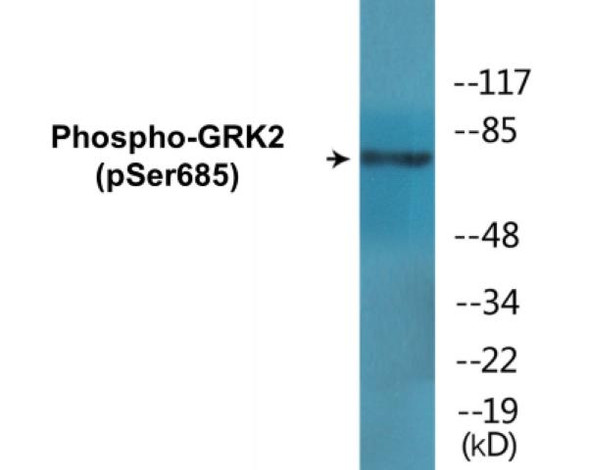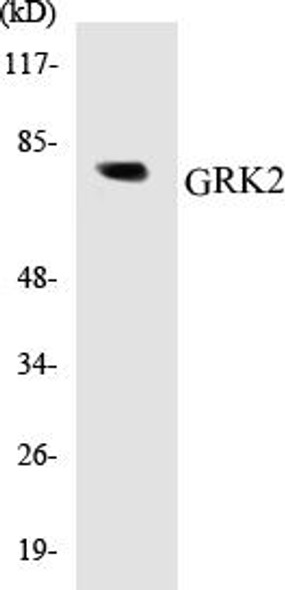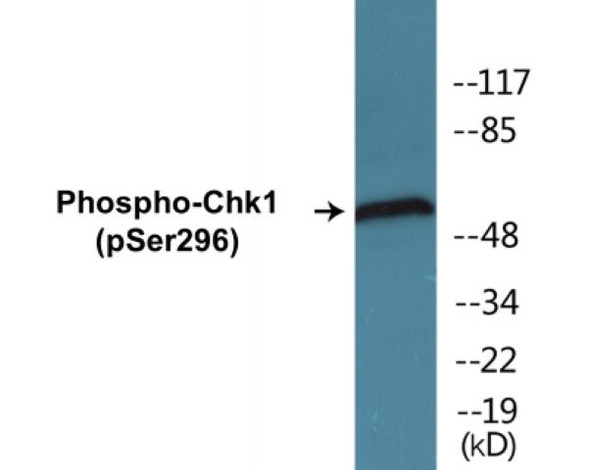Description
GRK2 (Phospho-Ser29)Colorimetric Cell-Based ELISA Kit
The GRK2 Phospho-Ser29 Colorimetric Cell-Based ELISA Kit is a highly sensitive and specific assay designed for the accurate detection of GRK2 phosphorylated at Ser29 in cell lysates. This kit provides reliable and reproducible results, making it ideal for researchers studying the role of GRK2 in cellular signaling pathways and disease mechanisms.GRK2, also known as G protein-coupled receptor kinase 2, is a key regulator of G protein-coupled receptor signaling and plays a critical role in modulating cellular responses to various stimuli. Phosphorylation of GRK2 at Ser29 has been shown to impact its activity and function, making it an important target for investigation in conditions such as cardiovascular diseases, diabetes, and neurological disorders.
By utilizing the GRK2 Phospho-Ser29 Colorimetric Cell-Based ELISA Kit, researchers can gain valuable insights into the regulatory mechanisms governing GRK2 phosphorylation and its downstream effects on cellular processes. This kit offers a simple and efficient method for quantifying phosphorylated GRK2 levels, enabling precise and detailed analysis of its involvement in disease pathogenesis and potential therapeutic interventions.
| Product Name: | GRK2 (Phospho-Ser29) Colorimetric Cell-Based ELISA |
| Product Code: | CBCAB00419 |
| ELISA Type: | Cell-Based |
| Target: | GRK2 (Phospho-Ser29) |
| Reactivity: | Human, Mouse, Rat |
| Dynamic Range: | > 5000 Cells |
| Detection Method: | Colorimetric 450 nm |
| Format: | 2 x 96-Well Microplates |
The GRK2 (Phospho-Ser29) Colorimetric Cell-Based ELISA Kit is a convenient, lysate-free, high throughput and sensitive assay kit that can detect GRK2 protein phosphorylation and expression profile in cells. The kit can be used for measuring the relative amounts of phosphorylated GRK2 in cultured cells as well as screening for the effects that various treatments, inhibitors (ie. siRNA or chemicals), or activators have on GRK2 phosphorylation.
Qualitative determination of GRK2 (Phospho-Ser29) concentration is achieved by an indirect ELISA format. In essence, GRK2 (Phospho-Ser29) is captured by GRK2 (Phospho-Ser29)-specific primary antibodies while the HRP-conjugated secondary antibodies bind the Fc region of the primary antibody. Through this binding, the HRP enzyme conjugated to the secondary antibody can catalyze a colorimetric reaction upon substrate addition. Due to the qualitative nature of the Cell-Based ELISA, multiple normalization methods are needed:
| 1. | A monoclonal antibody specific for human GAPDH is included to serve as an internal positive control in normalizing the target absorbance values. |
| 2. | Following the colorimetric measurement of HRP activity via substrate addition, the Crystal Violet whole-cell staining method may be used to determine cell density. After staining, the results can be analysed by normalizing the absorbance values to cell amounts, by which the plating difference can be adjusted. |
| Database Information: | Gene ID: 156, UniProt ID: P25098, OMIM: 109635, Unigene: Hs.83636 |
| Gene Symbol: | ADRBK1 |
| Sub Type: | Phospho |
| UniProt Protein Function: | GRK2: a ubiquitous protein kinase of the GRK family. Phosphorylates the beta-2-adrenergic receptor and related G-protein-coupled receptors. Appears to mediate agonist-specific desensitization observed at high agonist concentrations. Expression level is consistently elevated in chronic human heart failure. Mouse models of severe heart failure have been used to demonstrate that inhibition of BARK1 with a peptide inhibitor is sufficient to increase mean survival, reduce dialation and improve cardiac function. |
| UniProt Protein Details: | Protein type:Kinase, protein; EC 2.7.11.15; Protein kinase, Ser/Thr (non-receptor); Protein kinase, AGC; AGC group; GRK family; BARK subfamily Chromosomal Location of Human Ortholog: 11q13.1 Cellular Component: membrane; cytoplasm; plasma membrane; cytosol Molecular Function:G-protein coupled receptor kinase activity; protein binding; Edg-2 lysophosphatidic acid receptor binding; beta-adrenergic receptor kinase activity; alpha-2A adrenergic receptor binding; ATP binding; protein kinase activity Biological Process: epidermal growth factor receptor signaling pathway; desensitization of G-protein coupled receptor protein signaling pathway; tachykinin signaling pathway; fibroblast growth factor receptor signaling pathway; acetylcholine receptor signaling, muscarinic pathway; nerve growth factor receptor signaling pathway; heart development; peptidyl-threonine phosphorylation; signal transduction; negative regulation of striated muscle contraction; peptidyl-serine phosphorylation; negative regulation of the force of heart contraction by chemical signal; phospholipase C activation; receptor internalization; positive regulation of catecholamine secretion; innate immune response; cardiac muscle contraction |
| NCBI Summary: | The product of this gene phosphorylates the beta-2-adrenergic receptor and appears to mediate agonist-specific desensitization observed at high agonist concentrations. This protein is an ubiquitous cytosolic enzyme that specifically phosphorylates the activated form of the beta-adrenergic and related G-protein-coupled receptors. Abnormal coupling of beta-adrenergic receptor to G protein is involved in the pathogenesis of the failing heart. [provided by RefSeq, Jul 2008] |
| UniProt Code: | P25098 |
| NCBI GenInfo Identifier: | 126302521 |
| NCBI Gene ID: | 156 |
| NCBI Accession: | P25098.2 |
| UniProt Secondary Accession: | P25098,Q13837, Q6GTT3, B0ZBE1, |
| UniProt Related Accession: | P25098 |
| Molecular Weight: | |
| NCBI Full Name: | Beta-adrenergic receptor kinase 1 |
| NCBI Synonym Full Names: | adrenergic, beta, receptor kinase 1 |
| NCBI Official Symbol: | ADRBK1 |
| NCBI Official Synonym Symbols: | GRK2; BARK1; BETA-ARK1 |
| NCBI Protein Information: | beta-adrenergic receptor kinase 1; beta-ARK-1; G-protein coupled receptor kinase 2 |
| UniProt Protein Name: | Beta-adrenergic receptor kinase 1 |
| UniProt Synonym Protein Names: | G-protein coupled receptor kinase 2 |
| UniProt Gene Name: | ADRBK1 |
| UniProt Entry Name: | ARBK1_HUMAN |
| Component | Quantity |
| 96-Well Cell Culture Clear-Bottom Microplate | 2 plates |
| 10X TBS | 24 mL |
| Quenching Buffer | 24 mL |
| Blocking Buffer | 50 mL |
| 15X Wash Buffer | 50 mL |
| Primary Antibody Diluent | 12 mL |
| 100x Anti-Phospho Target Antibody | 60 µL |
| 100x Anti-Target Antibody | 60 µL |
| Anti-GAPDH Antibody | 60 µL |
| HRP-Conjugated Anti-Rabbit IgG Antibody | 12 mL |
| HRP-Conjugated Anti-Mouse IgG Antibody | 12 mL |
| SDS Solution | 12 mL |
| Stop Solution | 24 mL |
| Ready-to-Use Substrate | 12 mL |
| Crystal Violet Solution | 12 mL |
| Adhesive Plate Seals | 2 seals |
The following materials and/or equipment are NOT provided in this kit but are necessary to successfully conduct the experiment:
- Microplate reader able to measure absorbance at 450 nm and/or 595 nm for Crystal Violet Cell Staining (Optional)
- Micropipettes with capability of measuring volumes ranging from 1 µL to 1 ml
- 37% formaldehyde (Sigma Cat# F-8775) or formaldehyde from other sources
- Squirt bottle, manifold dispenser, multichannel pipette reservoir or automated microplate washer
- Graph paper or computer software capable of generating or displaying logarithmic functions
- Absorbent papers or vacuum aspirator
- Test tubes or microfuge tubes capable of storing ≥1 ml
- Poly-L-Lysine (Sigma Cat# P4832 for suspension cells)
- Orbital shaker (optional)
- Deionized or sterile water
*Note: Protocols are specific to each batch/lot. For the correct instructions please follow the protocol included in your kit.
| Step | Procedure |
| 1. | Seed 200 µL of 20,000 adherent cells in culture medium in each well of a 96-well plate. The plates included in the kit are sterile and treated for cell culture. For suspension cells and loosely attached cells, coat the plates with 100 µL of 10 µg/ml Poly-L-Lysine (not included) to each well of a 96-well plate for 30 minutes at 37°C prior to adding cells. |
| 2. | Incubate the cells for overnight at 37°C, 5% CO2. |
| 3. | Treat the cells as desired. |
| 4. | Remove the cell culture medium and rinse with 200 µL of 1x TBS, twice. |
| 5. | Fix the cells by incubating with 100 µL of Fixing Solution for 20 minutes at room temperature. The 4% formaldehyde is used for adherent cells and 8% formaldehyde is used for suspension cells and loosely attached cells. |
| 6. | Remove the Fixing Solution and wash the plate 3 times with 200 µL 1x Wash Buffer for five minutes each time with gentle shaking on the orbital shaker. The plate can be stored at 4°C for a week. |
| 7. | Add 100 µL of Quenching Buffer and incubate for 20 minutes at room temperature. |
| 8. | Wash the plate 3 times with 1x Wash Buffer for 5 minutes each time. |
| 9. | Add 200 µL of Blocking Buffer and incubate for 1 hour at room temperature. |
| 10. | Wash 3 times with 200 µL of 1x Wash Buffer for 5 minutes each time. |
| 11. | Add 50 µL of 1x primary antibodies Anti-GRK2 (Phospho-Ser29) Antibody, Anti-GRK2 Antibody and/or Anti-GAPDH Antibody) to the corresponding wells, cover with Parafilm and incubate for 16 hours (overnight) at 4°C. If the target expression is known to be high, incubate for 2 hours at room temperature. |
| 12. | Wash 3 times with 200 µL of 1x Wash Buffer for 5 minutes each time. |
| 13. | Add 50 µL of 1x secondary antibodies (HRP-Conjugated AntiRabbit IgG Antibody or HRP-Conjugated Anti-Mouse IgG Antibody) to corresponding wells and incubate for 1.5 hours at room temperature. |
| 14. | Wash 3 times with 200 µL of 1x Wash Buffer for 5 minutes each time. |
| 15. | Add 50 µL of Ready-to-Use Substrate to each well and incubate for 30 minutes at room temperature in the dark. |
| 16. | Add 50 µL of Stop Solution to each well and read OD at 450 nm immediately using the microplate reader. |
(Additional Crystal Violet staining may be performed if desired – details of this may be found in the kit technical manual.)






